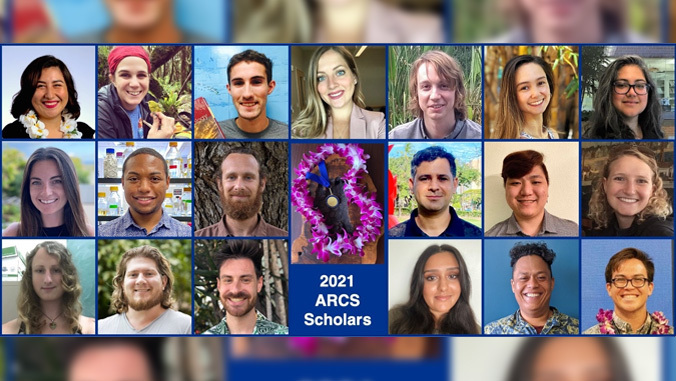
Nineteen University of Hawaiʻi at Mānoa doctoral candidates have been awarded $5,000 Scholar Awards from the ARCS Foundation—Honolulu Chapter. The 2021 award recipients are from six UH Mānoa units.
Institute for Astronomy student Erica Molnar Bufanda was named Scholar of the Year. Recipient of a George and Mona Elmore ARCS Award, Bufanda was selected by a panel of scientists for an additional $1,000 prize for submitting the best short video describing her research. She studies the chemical signatures imprinted on comets to determine if a habitable Earth is a common occurrence in solar system development or an anomaly.
ARCS Foundation is a non-profit volunteer group that works to advance science in America by providing unrestricted grants to outstanding U.S. graduate students in STEM fields. The Honolulu chapter has provided more than $2 million to UH graduate students since 1974.
Institute for Astronomy
Ryan Dungee received the Columbia Communications ARCSAward. His research lays important groundwork for other astronomers by improving image quality from telescopes using adaptive optics and benchmarking models for determining a star’s age.
College of Engineering
Khaldoon Ishmael received the Frederick M. Kresser Award. He works on non-invasive monitoring systems that use Doppler radar based on the ground or unmanned aerial vehicles to detect physiological signals, such as breathing and heart rate.
Harrison Togia received the Bretzlaff Foundation Award. He is engineering resilient methods for identifying hazards and adaptations for coastal communities using free access data, open source programming, evolving measures and deep learning.
College of Natural Sciences
Maria Constantini received a Maybelle F. Roth ARCS Award in Conservation Biology. She examines microbiome formation in the endangered ʻakikiki honeycreeper to improve captive breeding efforts.
Ana Flores received a Mona and George Elmore ARCS Award. She monitors plant productivity and growth to gauge their response to environmental stress changes through key developmental stages.
Jeffrey Schueler received the H. Keith and Sue Ernst ARCS Award. He tests predictions of quantum mechanics by studying decay properties of B-mesons—sub-atomic particles that are unstable and decay in interesting ways—generated in the international Belle supercollider experiment in Japan.
Jordan Gossett received the Jacqueline Maly ARCS Award. She studies the co-evolution of leafhoppers and their endosymbiotic bacteria, which provide essential nutrients that are not available in the lava tubes where the insects live.
Bryson Nakamoto received a Sarah Ann Martin ARCS Award. He is developing a method for screening materials to fast-track discovery of a hydrogen storage material.
Samantha Pilgrim received a Sarah Ann Martin ARCS Award. She studies the relationship between symmetries that preserve distances and those that can be approximated by symmetries of finite sets, an area of mathematics with potential applications in physics, engineering and materials science.
Manya Singh received a Maybelle F. Roth ARCS Award in Conservation Biology. She wants to know if invasive plants modify the soil and the organisms living in it in ways that impede native plant restoration, and how that will be affected by droughts related to climate change.
College of Tropical Agriculture and Human Resources
Jeremieh Hasley received the Ellen M. Koenig ARCS Award. He employs CRISPR gene editing technology to create a model papaya crop that researchers can use to study gene function in both papaya and slower growing fruit trees.
David Honsberger received the Helen Jones Farrar ARCS Award. He seeks natural parasites and predators of invasive wood-boring insects like the coffee berry borer and the beetle responsible for spreading Rapid Ohiʻa Death, and ways to improve their efficacy as biological control agents.
John A. Burns School of Medicine
Kaitlin Driesse Keegan received an Ellen M. Koenig ARCS Award. She is trying to determine if antibodies from infection with the Dengue virus contribute to the congenital defects related to infection from the closely related Zika virus.
Alexandru Sasuclark received the George and Virginia Starbuck ARCS Award. He investigates the role of the micronutrient selenium in development of cells that transmit signals between motor and sensory neurons and the net that surrounds them.
School of Ocean and Earth Science and Technology
Dillon Dodson received a George and Mona Elmore ARCS Award. He studies droplet clustering, which is related to droplet size and turbulent intensity, to better understand formation of precipitation.
Chiara Ferrari-Wong received the Toby Lee ARCS Award in Earth Sciences. She looks for predicted but yet-to-be detected organic compounds deposited on the Moon by solar winds.
Jessica Perelman received a George and Mona Elmore ARCS Award. She uses acoustic monitors to observe behavior of animals in the water column of a region targeted for deep-sea mining to inform development of marine protections.
Nicholas Ulm received an Ellen M. Koenig ARCS Award. He works on a wave energy buoy inspired by the Hālona blow hole to optimize power production and provide a stable docking station for autonomous ocean-observing research vehicles.
Read more about the 2021 ARCS Scholars.
This recognition is an example of UH Mānoa’s goal of Enhancing Student Success (PDF), one of four goals identified in the 2015–25 Strategic Plan (PDF), updated in December 2020.

